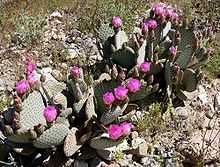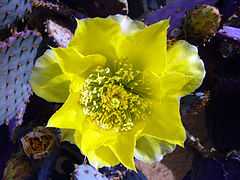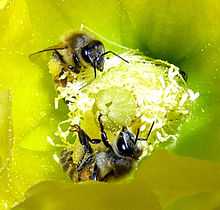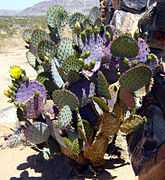Opuntia basilaris
| Opuntia basilaris | |
|---|---|
 | |
| Conservation status | |
| Scientific classification | |
| Kingdom: | Plantae |
| (unranked): | Angiosperms |
| (unranked): | Eudicots |
| (unranked): | Core eudicots |
| Order: | Caryophyllales |
| Family: | Cactaceae |
| Genus: | Opuntia |
| Species: | O. basilaris |
| Binomial name | |
| Opuntia basilaris Engelm. & J.M. Bigelow, 1857 | |
Opuntia basilaris, the Beavertail Cactus, is a cactus species found in southwest United States. It occurs mostly in the Mojave Desert, Anza-Borrego Desert State Park, and Colorado Deserts, and also in the Colorado Plateau and northwest Mexico; it ranges through the Grand Canyon and Colorado River region to southern Utah, and in western Arizona, regions along the Lower Colorado River Valley. The Beavertail Cactus is a medium-sized to small prickly pear cactus, depending on variety, growing to about 60 cm tall. A single plant may consist of hundreds of fleshy, flattened pads. These are more or less blue-gray, depending on variety, growing to a length of 14 cm and are maximum 10 cm wide and 1 to 1.5 cm thick. They are typically spineless, but have instead many small barbed bristles, called glochids, that easily penetrate the skin. The pink to rose colored flowers are most common; however, a rare variety of white and even yellow flowers also exist. Opuntia basilaris bloom from spring to early summer.
The species is variable in nature and several names under different ranks has been described to science. Only four of these are generally accepted.
- Opuntia basilaris var. basilaris
- Opuntia basilaris var. brachyclada - Little beavertail pricklypear
- Opuntia basilaris var. longiareolata - Elongated Beavertail Prickly Pear or Grand Canyon beavertail pricklypear
- Opuntia basilaris var. treleasei - Trelease's Beavertail Prickly Pear, Bakersfield Cactus (This variety is designated as endangered under the federal Endangered Species Act and California Endangered Species Act, which means that killing or possessing it is prohibited in California)
For full synonymy, see Wikispecies entry on Opuntia basilaris.
Some experts consider the Trelease's Beavertail to be a full species (Bowen 1987, R. van de Hoek). It is unique among the varieties of Opuntia basilaris in that the eye-spots contain spines in addition to the bristles; this indicates that the species does vary a lot in its exterior.
Chemistry
Opuntia basilaris contains 0.01% mescaline and 4-hydroxy-3-5-dimethoxyphenethylamine.[1]
Uses
The Cahuilla Native Americans used beavertail as a food staple. The buds were cooked or steamed, and then were eaten or stored. The large seeds were ground up to be eaten as mush. [2][3]
Gallery
-
_-_01.jpg)
Beavertail Cactus with buds in Joshua Tree National Park
-
_-_12.jpg)
Flowering Beavertail Cactus in Joshua Tree National Park
-
_-_15.jpg)
Large flowering Beavertail Cactus in Joshua Tree National Park
-
_-_24.jpg)
Pink Beavertail Cactus flower in full bloom in Joshua Tree National Park
-
_-_21.jpg)
Insect covered pink Beavertail Cactus flower in full bloom in Joshua Tree National Park
-

Yellow Beavertail Cactus flower in full bloom
-

Pollination of a yellow Beavertail Cactus flower, in California
-

Budding yellow Beavertail Cactus at Landers, California
| Wikimedia Commons has media related to Opuntia basilaris. |
References
- ↑ cite web|title=Plant Chemistry|http://findmeacure.com/2012/02/16/opuntia-basilaris/
- ↑ "Cahuilla Plants". enduringknowledgepublications.com. Retrieved 2012.
- ↑ "Temalpakh Ethnobotanical Garden". http://www.malkimuseum.org''. Retrieved 2007.
